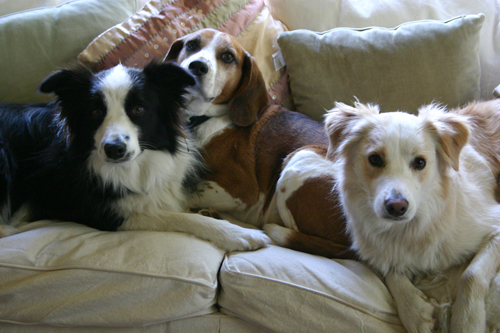
Why is it important to maintain your dog’s grooming schedule during the winter months? Caroline Zambrano answers your winter grooming questions.
It is essential to stick to your dogs grooming schedule during the winter months because colder weather often stimulates more hair/coat growth, says award-winning dog groomer Susie Simmons. “Our lifestyles and the role canines plays in our lives means our pets spend just as much time outside as inside in winter. This can really confuse what the coat was designed to do – one minute the hair follicles need to grow to keep your pet warm while outside; the next, they need to be shed because the heats on, says Simmons, who is the winner of the 2007 Dogs Life PIAA Pet People Awards for Best Grooming Service. [Check out page 57 of the #89 May/Jun issue for information on the 2008 awards or click on ‘Pet People Awards’ in the left column].
Double-coated breeds, like Samoyed, German Shepherd and Pomeranians, have coats that are designed to thicken up for insulation in cold climates, but they often live indoors in our heated environment during the winter.
Regular brushing
How can regular brushing prepare the coat for the colder months? Regular grooming/brushing through winter is paramount to maintaining your pets natural climate-control mechanism, Simmons says. Regular brushing in the winter removes the ‘shedding’ hair, thus avoiding matting, keeping the pet balanced temperature-wise and saving on vacuuming.Heating in our homes can often dry out or dehydrate dogs skin. Grooming, in turn, stimulates and conditions the skin and coat, Simmons says. Some breeds such as the Maltese, Shih Tzu, Lhasa Apso and Poodle – also require regular trimming and need to have their coats maintained through winter. Growing the hair long for winter can often result in increased matting, skin ailments and more importantly, restricted movement, Simmons says. How about grooming the feet? Keeping hair around paw pads trimmed will help keep your dogs paws free of ice and snow, which can ball up between footpads and create uncomfortable walking.
Foot care
The foot is your pets contact to its environment, and maintaining the hair on the feet can improve the overall movement of your pet, Simmons says. Most canines grow hair between the pads of each foot.Keeping this region of hair short allows the pad of the foot to work well – too much hair may cause excessive slipping on polished floorboards, tiles etc. When the pad hair is trimmed, short debris has nowhere to cling to – sand, burs and ice can contact the feet, but doesn’t stick around/mat in this small region.Nail maintenance is also paramount in winter months, as Dogs Life finds out. Walks often get shorter in winter due to daylight changes and the cold. Long nails don’t allow the pads to contact the ground correctly and can push the toes/digits outwards to a compromising position, Simmons says. The feet are very sacred to most canines; when this area is not maintained, many pets are quite uncomfortable and will excessively lick and chew this region.
Bathtime!
When you bathe your pet in the wintertime, there are a few things to consider before you turn on the water. Ensure the bath water is not too hot, dry your pets coat well and ensure there is no dampness if your pet is having to stay outside afterwards, Simmons says. If using a hairdryer, keep the heater off on your dryer to avoid [causing] heat-damage to your pets coat.Brushing tangles out prior to bathing will ensure no soap residue remains caught in a tangle to cause irritation. Many tangles turn into mats when they become wet, Simmons says.
You need to look after your pooch's health - check out our all-new DOGSLife Directory



